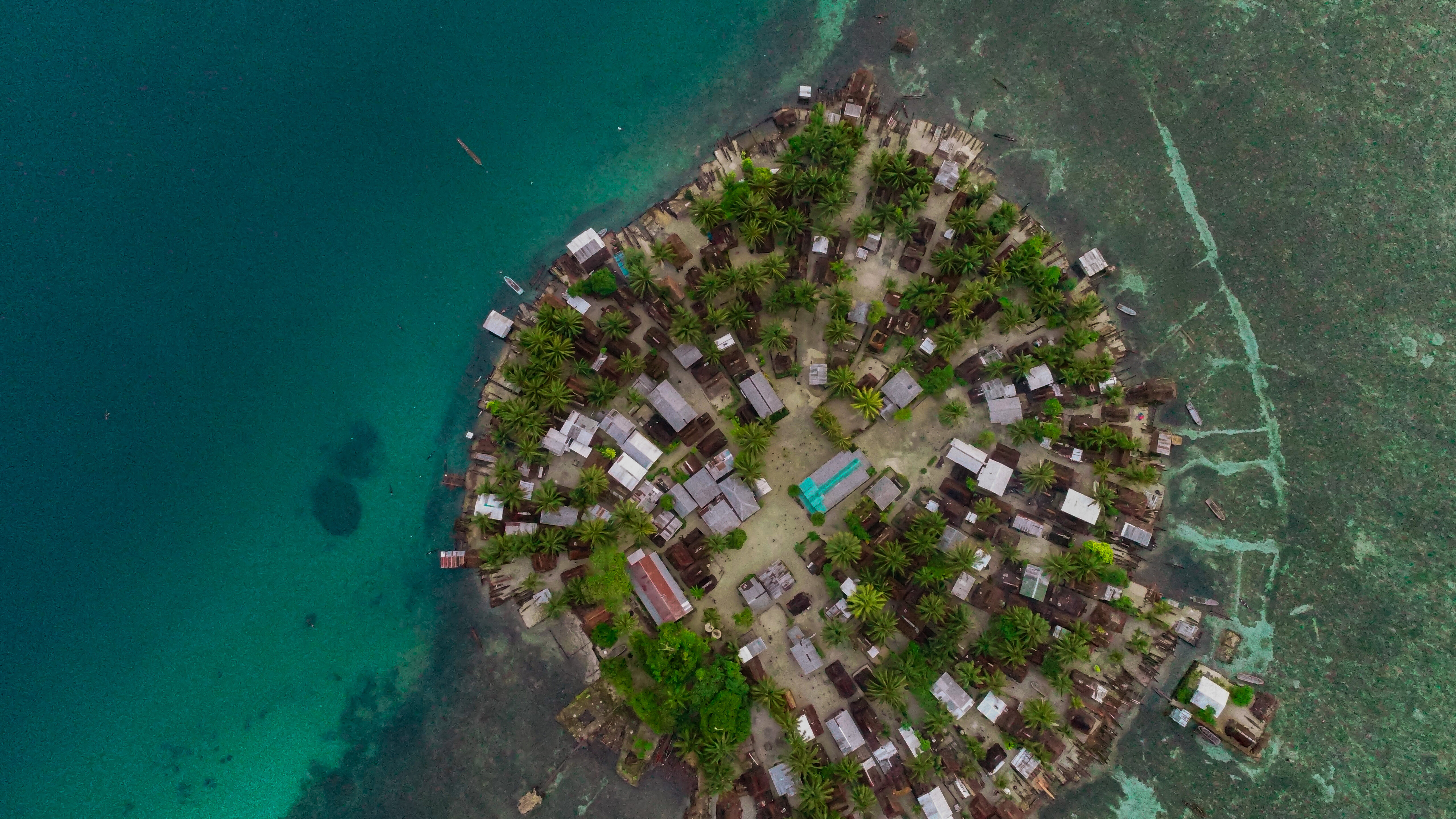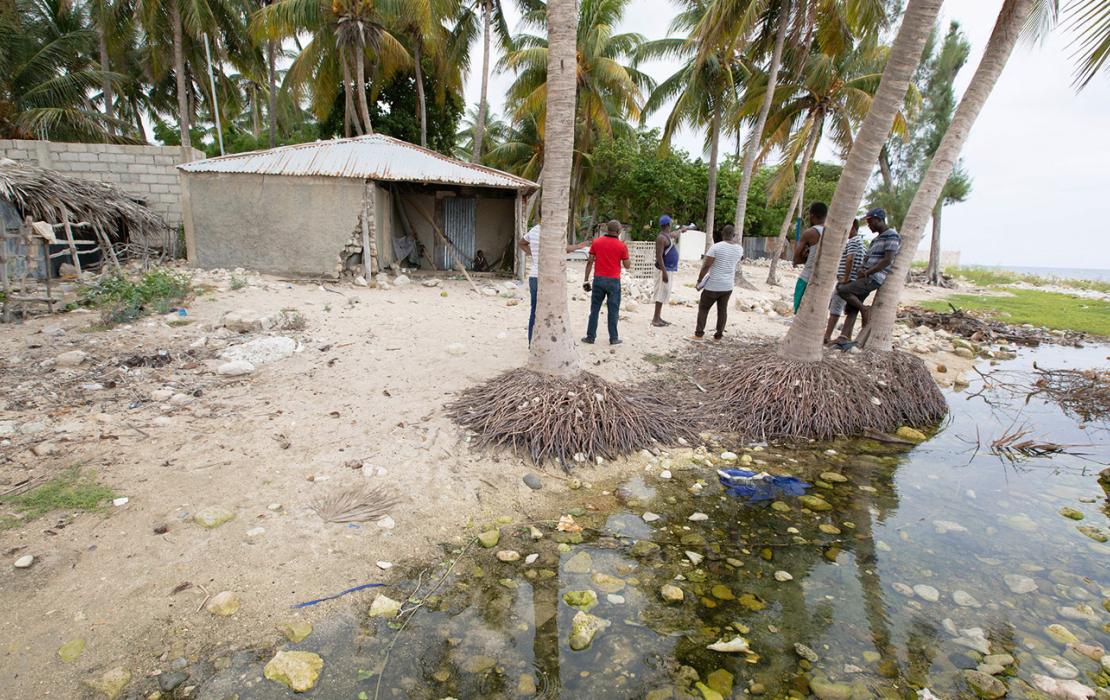
Photo: UNDP Papua New Guinea

Aerial view of Aromot Island, Papua New Guinea. Photo: UNDP Papua New Guinea
While their greenhouse gas emissions are comparatively low, Small Islands Developing States (SIDS) worldwide are shouldering the brunt of climate change impacts. Surrounded by ocean, they face hazards from every direction, including sea-level rise, extreme storm surges, tropical cyclones, marine heatwaves and ocean acidification. Meanwhile, rising temperatures and changing rainfall patterns threaten the food and water supply of the communities living on the islands.
Economic constraints, high debt burdens and the high costs of disasters – such as US$1 billion in damages from the tropical storms that hit Haiti in 2008 – are further challenges that these “hot spots” for climate change face. Some SIDS are also grappling with political turbulence and humanitarian emergencies driven by conflict. In these contexts, climate change is acting as a threat multiplier, exacerbating sources of tension and magnifying vulnerabilities.
Yet while they are on the frontlines of climate change – in fact, because of it – many SIDS are also at the forefront of adaptation, adopting a 360° response to protect communities, economies and ecosystems, with National Adaptation Plans at their heart.

The need for increased finance for adaptation, improved access to climate finance, and dedicated funding for loss and damage remains paramount for SIDS and other vulnerable nations. Photo: UNDP Papua New Guinea
The key role of National Adaptation Plans in the climate crisis
In 2024 all countries have begun the ambitious task of updating their climate goals, known as Nationally Determined Contributions (NDCs). NDCs are self-defined national climate action plans prepared by countries to set targets that cut emissions and adapt to climate impacts as part of a global effort under the Paris Agreement.
Key to designing and implementing these climate goals – required to be updated by countries every five years – are National Adaptation Plans, commonly known as NAPs. These plans are essentially blueprints for countries to set out where and how they need to adapt to climate change over the next five to ten years.
A successful NAP has several essential elements. These include efforts to grow institutional awareness; an in-depth, evidence-based understanding of a country’s risks and vulnerabilities; strong coordination across government; and identification of the top priorities that need to be implemented through mobilization of climate finance. At the same time, every NAP is unique, based on the context of the country.
For some countries, in which conflict and instability are complicating factors, long-term planning and building the capacity of institutions for a more resilient future are perhaps even more important.
Haiti, Papua New Guinea and Guinea-Bissau are three examples of fragile and conflict-affected Small Island Developing States making progress.

To enhance national resilience to climate change, the Government of Haiti has increased coordination and capacities across all institutions at multiple levels, including national, sub-regional and local. Photo: UNDP Haiti

Haiti published its National Adaptation Plan in early 2023. Photo: UNDP Haiti
Haiti increases cross-government capacity for national resilience
In 2019, Haiti’s Ministry of Environment began developing a NAP focused on integrating climate change risks into national development planning. Less than two years into the process, however, disaster struck: a 7.2-magnitude earthquake hit the country, killing more than 2,200 people, destroying homes and damaging vital infrastructure. The country was still recovering from a devastating 7.0-magnitude earthquake nine years earlier.
Despite these disasters, and while simultaneously facing a humanitarian and socio-political crisis, Haiti published its National Adaptation Plan in early 2023.
The country has prioritized building the knowledge and awareness of government officials in key areas. For example, officials from the Ministry of Environment have taken part in training focused on enhancing the climate resilience of the water sector, learning about the current situation and future projections of temperature, rainfall and aridity. The Ministry of Environment has also been working with its departments to ensure gender equality and social inclusion are top of mind when designing and implementing climate change adaptation projects and programmes. 10 institutions have been trained in how to integrate principles of inclusion into climate action and how to track whether efforts have been successful.
This capacity building, key to the National Adaptation Plan, will help strengthen the overall resilience of the country today and in future times of peace.

Papua New Guinea’s coastal communities face an uncertain future as climate change brings about sea level rise, increased inland water salinity, and the loss of marine life. Photo: UNDP Papua New Guinea

The impact of climate change-related hazards in Papua New Guinea has been increasing in intensity and frequency. Photo: UNDP Papua New Guinea
Papua New Guinea finances its climate action plans
As a nation with diverse ecosystems ranging from coastal areas to highland regions, Papua New Guinea is susceptible to a wide range of climate-related impacts. While rising sea levels pose a significant threat to the nation's low-lying coastal communities, inland communities face more frequent river flooding, and associated economic damages.
In the highlands, climate change is intensifying resource (food, water and energy) scarcity, poverty and displacement, compounded by reoccurring tribal violence. The population affected by river flooding, and its economic damages, are projected to double by 2030. Recurring disasters incur great humanitarian and economic costs. In the past month, more than 670 people are believed to have been killed and about 1,250 people had been displaced in a massive landslide in Yambali village in remote Enga province.
To build resilience for its people and land, Papua New Guinea completed the development of its National Adaptation Plan last year and launched it with the UNFCCC in April 2023. The NAP serves as a high-level strategic action plan to achieve climate adaptation in the four priority development sectors of agriculture, health, transport, and infrastructure.
To contribute to the government being able to finance or secure funding to put their plan into action, UNDP supported the development of a risk-informed planning and budgeting system through which resources can be better allocated towards building climate resilience. Three streams of funding will finance the NAP: domestic public finance, international resources, and earmarked (or protecting the allocation of) domestic revenue for climate action in the future.
A detailed financing framework for climate change adaptation in the medium- to long-term has also been created, helping to streamline national budgets to implement the country's adaptation priorities.
Papua New Guinea is one of the few countries in the Pacific region to have a NAP.

The meandering estuaries of Guinea–Bissau, 2018. Photo: NASA Earth Observatory

Children drawing water from a well in Pelundo village in the region of Cachungo. Guinea Bissau identifies water resources as a top adaptation priority alongside agriculture and livestock, energy, forestry, biodiversity, and fisheries. Photo: Gwenn Dubourthoumieu/UNDP Guinea Bissau
Guinea Bissau assesses climate risks for today and for the future
The Bijagós archipelago off the coast of Guinea-Bissau is made up of 88 small islands with rich natural resources, fishing communities and a high potential for a thriving tourism industry.
However, climate change impacts are intensifying across the islands and along Guinea-Bissau's 270km coastline, where nearly 80 percent of the population resides. Droughts and floods are having an immediate impact on the agriculture sector and farming communities, leading to loss of crops and livelihoods. Meanwhile sea-level rise poses a long-term threat to its archipelago and future tourism industry, which generated around US$2.90 million in 2020. These impacts underscore the urgent need for adaptation measures to safeguard communities and ecosystems.
At the same time, Guinea-Bissau is recognized as a nation facing significant political and institutional challenges. The recent political crisis following elections has further compounded these challenges, rendering the task of formulating and executing country-driven climate plans at the national level even more daunting.
Recognizing the need to establish a national plan to adapt to climate change now and into the future, Guinea Bissau began its NAP process by conducting a comprehensive risk assessment of climate change impacts in both the tourism and agriculture sectors. The resulting data will be housed in an online system accessible across ministries. Having all the country’s climate data accessible in one place will help inform ministries during the next revision of the NDCs in 2025.
Meanwhile, a tracking system helps monitor and evaluate progress in implementing adaptation measures as well as financing. This system will inform the revision of Guinea Bissau’s NDC next year, with the country now better positioned to further enhance its climate goals for 2030.
---
UNDP assists government partners including in Haiti, Papua New Guinea and Guinea-Bissau, to integrate climate change adaptation into policies, strategies and planning at national and local levels through support to NAP processes.
Since 2021, UNDP has worked with the following vulnerable Least Developed Countries (LDCs) to finalize their first NAP: Bangladesh, Benin, Bhutan, Burundi, Central African Republic, Chad, DR Congo, Haiti, Mozambique, Niger, South Sudan, Sierra Leone and Timor Leste. To learn more, visit www.adaptation-undp.org

